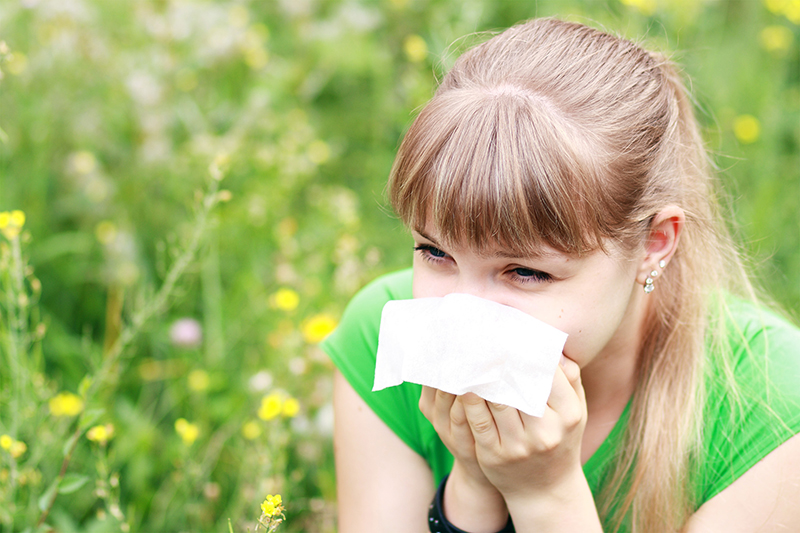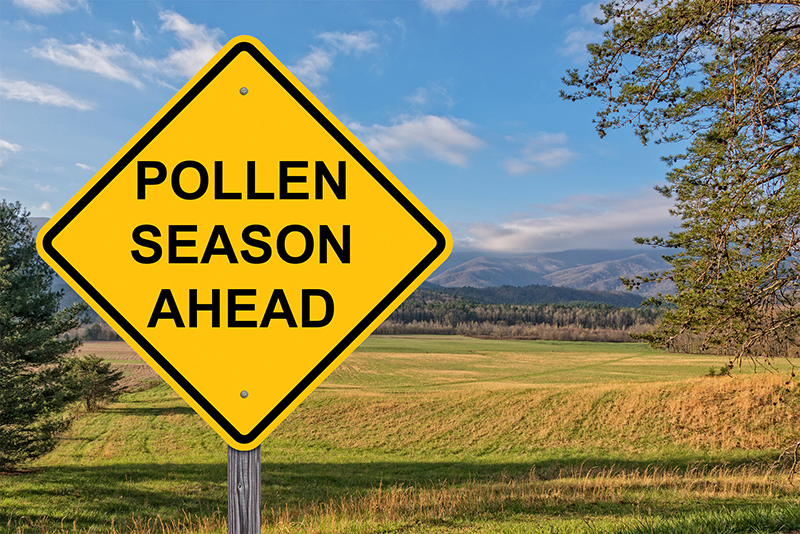Essential Tips for Contact Lens Wearers with Seasonal Allergy

As the cold winter finally comes to an end, and beautiful flowers start blooming in gardens and parks, we can sense the arrival of the tranquil spring season. However, for those who suffer from hay fever (allergic rhinitis), this season might become somewhat melancholic.
Seasonal allergies, also known as hay fever, occur when pollen enters the eyes or nose, prompting the body's immune system to identify it as a "foreign substance = enemy." Consequently, the immune system produces specific antibodies known as IgE antibodies. As time passes, these antibodies gradually accumulate within the body.
Once the accumulation reaches a certain level, exposure to pollen can trigger allergic reactions, resulting in symptoms such as sneezing, a runny nose, and nasal congestion.
If someone who previously hasn’t experienced seasonal allergies suddenly develops them, it's most likely caused by the accumulated antibodies reaching a threshold level.
This threshold sets off allergy symptoms upon exposure to pollen.
Discover these useful tips to ensure maximum comfort for your eyes, specifically tailored for individuals experiencing eye problems due to seasonal allergy.
Limit Outdoor Exposure to Minimize Symptoms

The most crucial aspect for alleviating symptoms is to avoid letting pollen enter the body. Pollen levels typically rise during windy, sunny, and dry weather conditions.
These ideal conditions facilitate the airborne dispersion of pollen, which can be beneficial for the ecosystem but the pollen can cause discomfort for your eyes and respiratory system.
Dust and pollen are allergens that can accumulate on the surface of your contact lenses. It's beneficial to stay indoors and take proactive measures to shield your eyes from these allergens, reducing eye irritation.
However, there are many situations where going outside is unavoidable.
When going outside, try to wear glasses, sunglasses, a hat, a mask, and a scarf as much as possible, and choose clothing that is less likely to collect pollen (smooth cotton, polyester, etc.) to prevent pollen from entering or sticking to you.
Also, when you return home, remove any pollen at the entrance and avoid bringing it indoors. During times of high pollen dispersal, it's essential to close doors and windows to prevent pollen from entering through them. If indoor air quality is a concern, using an air purifier can be helpful. Also, frequent house cleaning is crucial to remove pollen that may have entered indoors.
It is necessary to gargle and wash your face to remove the pollen.
Arrange the indoor environment
During times of high pollen dispersal, it's essential to close doors and windows to prevent pollen from entering through them.
If indoor air quality is a concern, using an air purifier can also be helpful. Also, frequent cleaning is crucial to remove pollen that may have entered indoors.
Consider switching to daily disposable contact lenses
Even those who typically use fortnightly or monthly contact lenses and suffer from hay fever can find it beneficial to switch to 1-day disposable contact lenses during this season. Since pollen can easily adhere to contact lenses, switching to daily disposable lenses allows for minimizing hay fever-related eye symptoms. By replacing them daily, you can effectively alleviate the discomfort caused by pollen allergies.
Wearing contact lenses that minimize exposure to pollen
During the pollen season, it is advisable to opt for non-ionic contact lenses or lenses made from materials that repel pollen. These lenses are less prone to attracting pollen and dust, leading to a reduction in allergic reactions. However, individual eye conditions and comfort preferences vary, so consulting an eye care professional is essential to select contact lenses that prioritize eye health and comfort.
One of the causes of contact lens contamination is when the negative ions on the lens attract positively charged proteins and other substances.
These proteins are not only present in tears but also in pollen. Pollen can be troublesome because it contains lipids, making it harder to remove when it adheres to contact lenses.
By choosing non-ionic materials for contact lenses, contaminants are less likely to be attracted, resulting in clearer and longer-lasting vision.
Popular non-ionic daily contact lenses
Dailies Aqua Comfort Plus (30 Pack)(Daily Lenses)
SofLens 38 (6 Pack) (Monthly Lenses)
There are contact lenses designed with high lubrication from hydrophilic polymers that envelop the material surface, reducing the likelihood of pollen adhesion.
Dailies Total 1 (30 Pack)(Daily Lenses)
PRECISION1 (30 Pack)(Daily Lenses)
Thanks to advanced surface-guarding technology, certain contact lenses effectively block pollen adhesion and deposition.
Air Optix Hydraglyde (6 Pack)(Monthly Lenses)
Maintain regular cleaning of your contacts lenses
Keeping your contact lenses as clean as possible. Take the time to clean your contacts thoroughly during allergy season. This will help remove allergens and buildup, plus prevent further irritation.
Relieve hay fever symptoms with effective eye drops
Using eye drops for symptoms such as itchy and red eyes caused by hay fever is an effective way.
Various types of eye drops are available to alleviate allergy symptoms associated with hay fever. Keep in mind that certain eye drops may necessitate the removal of contact lenses before application, so caution is advised. Consulting an eye doctor is essential to select the appropriate eye drops and follow the correct prescription for your specific symptoms.
Opt for eyeglasses instead of contact lenses

During the pollen season, switching to eyeglasses instead of contact lenses can be a helpful approach. Using eyeglasses provides protection for your eyes against pollen and offers the added benefit of being more convenient for applying eye drops.
Consider switching to glasses, especially on days with high pollen levels, when spending time outdoors.
Consult with your eye doctor

In the case of hay fever symptoms, itching is the most typical manifestation.
While the eyes themselves may feel itchy, the areas around the eyelids and eyelid edges are particularly prone to experiencing intense itching that worsens with scratching.
This is a characteristic feature of allergic reactions, making it necessary to seek appropriate treatment to alleviate the itching.
Moreover, symptoms can vary from person to person and may include redness, tearing, a gritty sensation, a feeling of "foreign object" in the eye, and allergic reactions that manifest on the backside of the eyelids or with eye discharge.
If hay fever-related eye symptoms are severe, treatment approaches may differ for each individual, so it is recommended to seek a proper examination from an eye doctor and receive the appropriate treatment.
For those who suffer from hay fever symptoms, this can be a challenging time. However, we hope that this article will be helpful for your eye health!